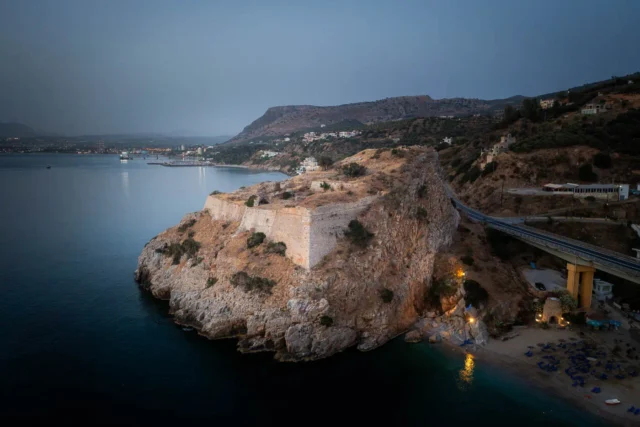A Stronghold Besieged
The Agios Andreas Bastion and Gate, integral components of the Heraklion fortifications, stand as silent witnesses to the city’s tumultuous past. Situated on the northwestern edge of the walls, they faced the brunt of Ottoman attacks during the epic Siege of Candia and ultimately marked the end of Venetian rule in Crete.
Design and Construction
The Agios Andreas Bastion, named after a nearby church dedicated to Saint Andrew, was a crucial defensive point in the Venetian walls. Constructed in the mid-16th century, it was designed to protect the city from naval attacks. Unlike the bastions on the landward side, Agios Andreas Bastion was not a full bastion. Due to its coastal position, it had a single flank and a low terreplein, making it somewhat weaker than other bastions.
The Agios Andreas Gate, also known as the “Yialos Porta” (Sea Gate), provided access to the city from the harbor. It was a smaller gate compared to the main land gates, reflecting the lesser volume of traffic expected from the seaward side.
The Siege of Candia and the Fall of the Bastion
The Agios Andreas Bastion played a pivotal role during the Siege of Candia (1645-1669), the longest siege in history. The Ottomans focused their attacks on the weaker seaward walls, including the Agios Andreas Bastion.
In 1667, a Venetian-Cretan engineer, Andrea Barozzi, defected to the Ottoman side. He provided crucial information about the fortifications’ weaknesses, particularly highlighting the vulnerability of the Agios Andreas and Sabbionara Bastions. This intelligence led the Ottomans to concentrate their attacks on these points.
By 1669, the relentless Ottoman bombardment had taken its toll. The Agios Andreas Bastion was heavily damaged, and the defenders were exhausted. The Ottomans finally breached the walls in this area, marking a turning point in the siege. Despite the heroic resistance of the Venetians and their allies, Candia eventually fell to the Ottomans in September 1669.
Ottoman Modifications
Following the Ottoman conquest, the Agios Andreas Bastion was rebuilt and strengthened. The Ottomans, recognizing its strategic importance, transformed it into a formidable defensive structure. They also renamed the Agios Andreas Gate to “Yürüş Kapısı” (Assault Gate), a grim reminder of the final assault that led to the city’s capture.
Demolition and Modernization
In the early 20th century, Heraklion underwent modernization efforts. Unfortunately, this led to the demolition of the Agios Andreas Gate to make way for the city’s coastal road. This decision, driven by a lack of appreciation for historical monuments at the time, resulted in the loss of a significant part of the city’s heritage. Only the southern section of the gate’s arch remains today, a poignant reminder of its former existence.
Opening to the Public
In recent years, there has been a growing awareness of the importance of preserving and showcasing Heraklion’s historical heritage. Although the Agios Andreas Gate is lost, the Agios Andreas Bastion remains a significant part of the city walls. Efforts have been made to conserve and maintain the bastion, allowing visitors to explore its history and appreciate its architectural features. The area around the bastion is now a pedestrian zone, offering a pleasant space for residents and tourists to enjoy.
The Walls Today
The Venetian walls of Heraklion, including the Agios Andreas Bastion, are remarkably well-preserved. They stand as a testament to the city’s rich history and the ingenuity of Venetian military engineering. Walking along the walls, visitors can imagine the fierce battles that took place centuries ago and appreciate the strategic importance of these fortifications.
The walls also offer stunning views of the city and the surrounding area. From the top of the Agios Andreas Bastion, visitors can see the harbor, the old town, and the mountains in the distance. It is a truly breathtaking sight and a reminder of the enduring legacy of Heraklion’s fortifications.
Fortifications: Key Points
- Construction Period: Mid-16th century
- Location: Northwestern side of the Heraklion Walls
- Dimensions: (Specific dimensions of the bastion are not readily available)
- Historical Significance: Crucial defensive point, witnessed the fall of Candia to the Ottomans
- Current Status: Bastion remains intact and is open to the public; Gate demolished in the early 20th century
References
- Sythiakaki, V. (2020). The Heraklion Fortifications: A Different View. In N. Chr. Stampolidis & E. Papadopoulou (Eds.), Crete: Emerging Cities. Athens: Museum of Cycladic Art-ΥΠΠΟΑ.
- Georgopoulou, M. (2001). Venice’s Mediterranean Colonies. Architecture and Urbanism. Cambridge: Yale University-Cambridge University Press.
- Tsigonaki, C. (2012). Historical and Archaeological Evidence from Gortyn and Eleutherna, Crete (4th-8th c.). In T. Kioussopoulou (Ed.), Byzantine Cities, 8th-15th c. Rethymno: School of Philosophy, University of Crete.
- Andrianakis, M. (1997). The Old City of Chania. Athens: Adam Editions.
- Bassilakis, A. (2010). Late Minoan Shipsheds at Katsambas, Heraklion. In M. Andrianakis & I. Tzachili (Eds.), Archaeological Work in Crete 1. (pp. 285-293). Rethymno: School of Philosophy, University of Crete.




























There are no comments yet.